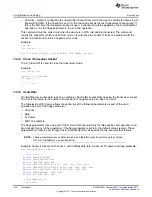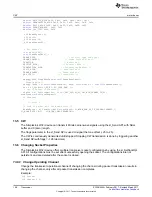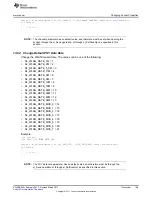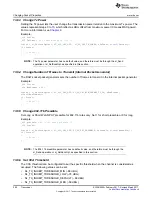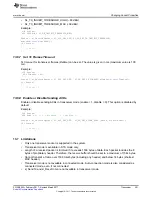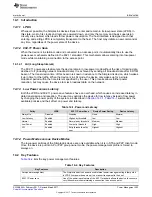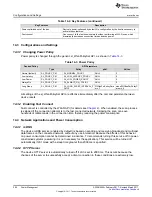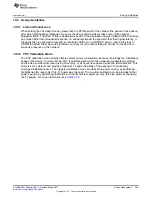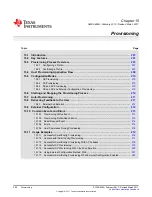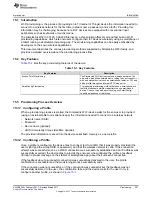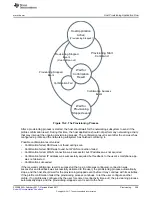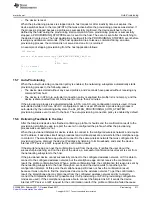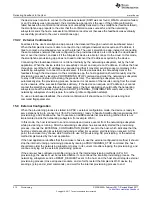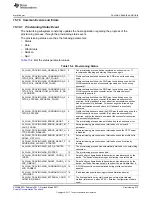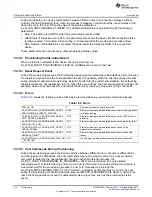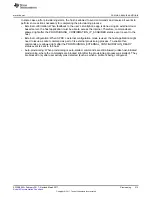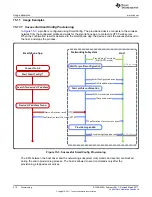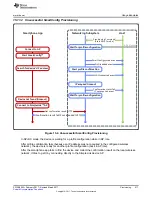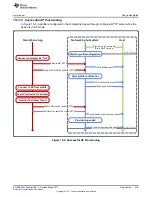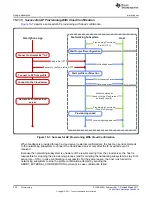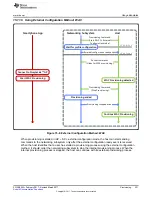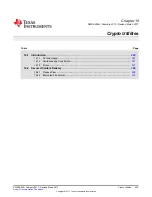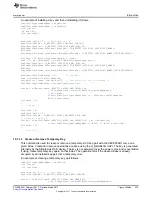
Configuration Modes
210
SWRU455A – February 2017 – Revised March 2017
Copyright © 2017, Texas Instruments Incorporated
Provisioning
Updates regarding the progress of the provisioning process are constantly sent by the networking
subsystem to the host.
15.5 Configuration Modes
The provisioning process can be started in four different configuration modes: AP provisioning, SC
provisioning, AP+SC provisioning, and AP+SC+External configuration mode.
15.5.1 AP Provisioning
In this configuration mode, The SimpleLink Wi-Fi device is in AP role, creating a wireless network of its
own with a predefined network name. Users can connect with an external device (such as a tablet or
smartphone running a dedicated provisioning app) to the SimpleLink AP and can configure a profile
through the SimpleLink HTTP server.
15.5.2 SC Provisioning
SmartConfig is a TI proprietary provisioning method that uses a smartphone or a tablet to broadcast
network credentials to an unprovisioned device. In this mode, the SimpleLink Wi-Fi device is in STA role,
scanning for SmartConfig data broadcasts. Users can configure a profile using any SmartConfig-capable
tablet or smartphone app.
15.5.3 AP and SC Provisioning
In this mode, the SimpleLink Wi-Fi device is in AP role, simultaneously scanning for SmartConfig
broadcasts. Users can either connect with an external device (such as a tablet or a smartphone running a
dedicated provisioning app) to the SimpleLink AP and configure a profile through the SimpleLink HTTP
server, or configure a profile using SmartConfig.
15.5.4 AP and SC and External Configuration Provisioning
In this mode, the SimpleLink Wi-Fi device is in AP role, enabling users to use AP provisioning or
SmartConfig provisioning (same as AP+SC mode), or in addition, to use an external configuration method
executed by the host application (for example, WAC provisioning).
15.6 Starting and Stopping the Provisioning Process
The provisioning process can be started after receiving an explicit request from the host application. When
the host initiates the provisioning process, it should provide the desired configuration mode, the role
(AP/STA) to which the device should switch in case of a successful provisioning, and an inactivity time-out
value which defines the period of time (in seconds) the system waits before it automatically stops the
provisioning process when no user activity is detected. During provisioning, the device may have higher
power consumption than usual, so TI does not recommend using long inactivity time-out values (of more
than few minutes).
An example of starting provisioning from the host application (in AP+SC configuration mode):
_i32 status;
status = sl_WlanProvisioning(SL_WLAN_PROVISIONING_CMD_START_MODE_APSC,
ROLE_STA,
PROVISIONING_INACTIVITY_TIMEOUT,
NULL, 0x0);
If
(0 > status)
{
/* handle error */
}
Once the provisioning process has started, it continues running until one of the following occurs:
•
A configured profile is successfully confirmed.
•
The host requested to stop the provisioning process by issuing a provisioning stop command.
•
There was no user activity for some time (defined by the inactivity time-out parameter).

